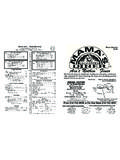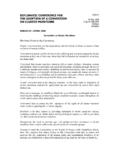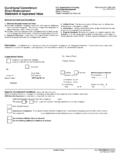Transcription of Improving ma mmalia n cell fa ctories: The selection …
1 T r e n d s i n Cell & Molecular B i o l o g y Vol. 1, 2006. Improving mammalian cell factories: The selection of signal peptide has a major impact on recombinant protein synthesis and secretion in mammalian cells Beate Stern1,2, Lene C. Olsen1, Christiane Tr e 2, Hanne Ravneberg2 and Ian F. Pryme1,2,*. 1. Department of Biomedicine, University of Bergen, Jonas Lies vei 91, N-5009 Bergen, Norway. 2. UniTargetingResearch AS, Thorm hlensgate 55, N-5008 Bergen, Norway ABSTRACT demonstrates that a native signal peptide is not Although mammalian cell factories are now necessarily always the most effective. The signal widely used in production of biomedically peptide from Metridia, seven oikosin signal important proteins they are still relatively peptides derived from Oikopleura and two ineffective compared with those from prokaryotic prokaryotic signal peptides all proved to be far organisms.
2 In an attempt to improve the CHO cell inferior to the Gaussia luciferase signal peptide line we have used a biotechological approach to with respect to recombinant luciferase production investigate whether or not the choice of signal in CHO cells. Overall the results described here peptide may have a major impact on the synthesis/ indicate the vital importance of selection of the secretion of a recombinant protein (Gaussia signal peptide when aiming to produce maximal luciferase) in transfected cells. In experiments amounts of recombinant protein in a mammalian where the native luciferase signal peptide was expression system. replaced with that derived from a series of sources the amount of luciferase produced varied by a KEYWORDS : CHO cells, Gaussia princeps, factor of more than 100.
3 The most effective signal Oikopleura dioica, Vargula hilgendorfii, Metridia peptide being that derived from Gaussia longa, signal sequence, oikosins, luciferase luciferase. Surprisingly two signal peptides of mammalian origin, human interleukin-2 and INTRODUCTION. albumin, proved to be far inferior to the signal During the last two decades the number of peptide derived from the marine organism. A recombinant proteins for therapeutic and research reduction in level of mRNA available for purposes on the market has increased substantially, translation proved not to be responsible for the and a further dramatic growth in the demand for major decrease observed in luciferase production. protein and peptide drugs and specific antibodies When tested in a hepatic cell line (HepG2) the is expected within the next 10-20 years [1, 2].
4 Marine luciferase signal peptide again proved to be superior to that from albumin. The Gaussia Prokaryotic cells were originally the most luciferase signal peptide was also much more commonly used host for recombinant protein effective than that derived from Vargula luciferase production, since they are easy to work with and in production of Vargula luciferase. This divide rapidly, making it possible to produce large amounts of protein at low costs. However, when eukaryotic proteins are produced in prokaryotes, *Corresponding author they might lack the proper folding and the post- translational modifications (PTMs) necessary for Beate Stern et al. their function [3]. Another problem with production elements involved at each level being highlighted. of proteins in prokaryotes, or even simple eukaryotes A brief section concerns the reporter protein used, such as yeast, is the possibility of allergic reactions in a naturally secreted luciferase from the copepod humans if the proteins are to be utilised for medicinal Gaussia princeps.
5 The final section reviews the purposes. Therapeutic use of proteins purified from work performed to study the effects of signal bacteria can also lead to a build-up of endotoxins peptides from various sources on production of and other possibly harmful substances [4]. recombinant proteins in transfected CHO cells. To obtain fully functional and therapeutically safe proteins, production in mammalian cells is OVERVIEW. therefore often imperative. Mammalian cells are Improvement of mammalian cell factories much more advanced than prokaryotes; they have through vector optimisation the appropriate organelles containing enzymes to Modifying the vector (both the backbone and the perform PTMs ( glycosylation and acetylation). insert containing the gene of interest) can greatly and chaperones to ensure proper folding.
6 Production influence the total amount of protein produced in mammalian cells results in recombinant proteins from each cell. Most attention has so far been with biophysical, biochemical, and therefore also directed to the promoter and its associated the functional properties that are comparable to elements in order to increase transcription levels. those of their natural counterparts. For these The promoters used are generally derived from the reasons, 60-70% of all recombinant, therapeutic genes of animal viruses or highly expressed proteins are currently being produced in mammalian mammalian genes, with the viral CMV and SV40. cells [5], with Chinese Hamster Ovary (CHO) cells promoters being the most commonly used. being one of the most commonly used cell types [2].
7 An example of another technological advancement Mammalian cells are much more demanding and is the addition of chromatin modulator elements, expensive to cultivate than bacteria. While a such as insulator or matrix attachment region bacterial cell can divide in 20 minutes, it may take (MAR) elements, in the vector. MAR elements are 24 hours or more for a mammalian cell to complete AT-rich DNA segments which act as attachment mitosis. Mammalian cells are also much more points of chromatin loops to the nuclear matrix. sensitive to contamination and to growth conditions, Each loop has independent transcription activity, requiring expensive growth medium and incubators. and the MAR element is thought to insulate the To ease the use and minimize the expense of gene(s) in the loop from the influence of the mammalian cell cultures, it would be desirable if surrounding chromatin.
8 Including such elements in each cell in a population could produce as much of a vector usually results in increased transcription the protein of interest as possible, and for it to be of the gene of interest, probably because the efficiently secreted into the medium for convenient insulation effect will reduce the effect of the collection and purification. transgene's positioning in the genome of the In the past few years a lot of work has been put transfected host, and because of MAR's ability to into increasing the production of protein from inflict topological changes on the chromatin [6-9]. mammalian cells, both with regards to optimising The sequences in the transcript generated from the growth conditions as well as to using genetic transgene could also be important for the level of engineering to modify the vectors and specific protein produced from a transfected cell.
9 With features of the host cells themselves [2]. However, increasing knowledge about regulatory elements more work is still needed, particularly when it within the 5' and the 3' untranslated regions (UTR). comes to optimising vectors especially with respect of the transcripts with regards to mRNA, to post-transcriptional phenomena. targeting, stability and translatability [10-13], it is An overview of the various stages of protein clear that these sequences need to be considered production in mammalian cells, with a focus on when generating a DNA construct for protein secreted proteins, is presented. Relevant regulatory expression [14]. Signal peptides in recombinant protein synthesis Regulation of transcription and translation Many genes have a TATA box (consensus A cell requires different concentrations of its TATAWAWR, where W is A or T, and R is a various proteins for proper function.)
10 Some proteins purine) [19] and/or an initiator element (Inr, are constantly required, such as actin, whereas consensus YYA+1 NWYY, where Y is a pyrimidine, others are needed only in short bursts, W is A or T, and N any nucleotide) [16]. The TATA. regulatory proteins such as c-myc. To finely tune box is generally located between 28 and 33 base the levels of proteins a cell has various ways of pairs upstream of the transcription initiation site regulating the quantity of the different transcripts [20], and is bound by the TATA-binding protein and the proteins they encode in most of the steps (TBP) [19]. The binding of the TBP promotes the undertaken until the release of the polypeptide binding of TFs and RNAP II, forming the pre- from the polysome. Proteins for secretion are initiation complex (PIC) [21].





